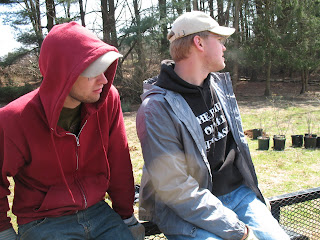It is remarkable how close ten strangers can become over the course of eight days. Our last few nights together were spent talking late into the evening at our very last campfire and doing the last few bonding activities that Caroline and I had planned. Blogging was not at the top of our priority list.
However, what we (along with over a hundred other volunteers) managed to pull off the Friday and Saturday before we departed for College Park is certainly noteworthy, so I have decided to recap our final accomplishments.
The hour and a half drive from CBF to one of Baltimore County's farms was a beautiful one. The sun was out as we drove through the long and winding roads of Falls Drive (please ignore my frequent Beatles song references). When we arrived on Friday, we helped our new friend Rob, a watershed restoration scientist, set up for Saturday morning's volunteer project that consisted of over 100 volunteers around the state plant 1,400 tress and shrubs. We learned that this helps prevent runoff and erosion into the Chesapeake Bay: one of the crucial necessities to improve the drinking water quality in Maryland. The setting up included strategic placing of several different kinds of Oak trees, Sycamores, and Redbuds, all of which were unloaded and carried mostly by hand to the pre-augered holes drilled into the ground by a very helpful and witty farmer named Skip. Caroline and I even got interviewed by a local news reporter about Maryland's AB program and some of the other activities we helped with during our week. (Look for the article in the Carroll Eagle!) At the end of the day, we all agreed that watching a multi-acre open field turn into an amateur forest within hours was truly amazing.
Despite the rain, mud, cold, questionable sleeping conditions, lighting, and a little bit of blood shed, we, as a team, managed to make a difference in the world far beyond what one could ever try to make tangible. Go us! :)
To Laura, Rob, Karl, and the other supportive CBF staff, thank you so much for the hard work you preform every day to ensure the conditions of the state (and beyond!) that we live in. Please let us know about future projects that arise... we are already excited to lend our ten sets of hands to you again.
To my phenomenal AB participants, Co-Trip Leader, and Staff Advisor, I miss you all dearly! But remember, this is not goodbye. It is the start of something greater...
See you all soon :)
Kathryn















































